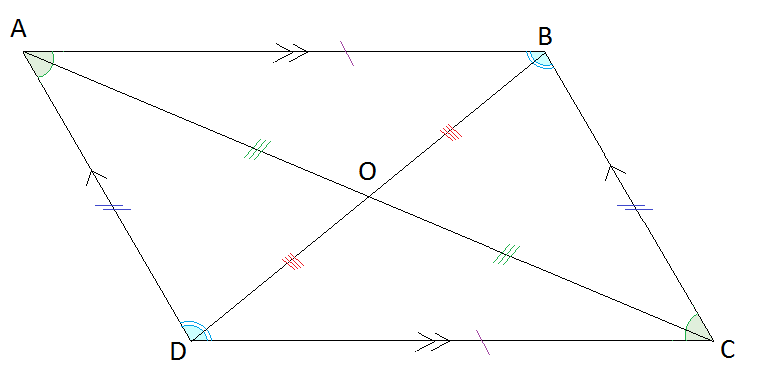9.08 Constructing quadrilaterals (Investigation)
We know that a quadrilateral is a polygon with 4 sides, this means that quadrilaterals also have 4 interior angles. The other known fact we have is the the sum of the interior angles of a quadrilateral is 360\degree.
There are a number of different types of quadrilaterals, and they all have specific properties.
Properties of quadrilaterals

Parallelogram
- Opposite sides in a parallelogram are parallel
- Opposite angles in a parallelogram are equal
- Opposite sides in a parallelogram are equal
- Diagonals of a parallelogram bisect each other

Rectangle
- Opposite sides in a rectangle are parallel
- Opposite sides in a rectangle are equal
- Diagonals of a rectangle bisect each other
- Diagonals in a rectangle are equal

Square
- All sides of a square are equal
- Opposite sides in a square are parallel
- Diagonals of a square are perpendicular to each other (cross at 90°)
- Diagonals of a square bisect the angles at the vertices (makes them 45°)
- Diagonals of a square bisect each other
- Diagonals of a square are equal
Rhombus

- Opposite angles of a rhombus are equal
- Opposite sides in a rhombus are parallel
- All sides of a rhombus are equal
- Diagonals of a rhombus bisect each other at 90 degrees
- Diagonals of a rhombus bisect corner angles
- Diagonals of a rhombus bisect each other

Trapezium
- An isosceles trapezium (trapezoid) has 2 pairs of adjacent angles equal
- A trapezium (trapezoid) has one pair of opposite sides parallel
- An isosceles trapezium (trapezoid) has one pair of opposites sides equal
- Diagonals of an isosceles trapezium (trapezoid) are equal
Kite

- A kite has 2 pairs of adjacent sides equal
- A kite has 1 pair of opposite angles equal
- The longest diagonal of a kite bisects the angles through which it passes
- Diagonals of a kite are perpendicular to each other
- The longest diagonal of a kite bisects the shorter diagonal
Bisect means to cut something into two equal parts. If you bisect a line, you cut it into two right in the middle.
Let's explore what kind of criteria we need to be explicitly given to be able to draw a unique quadrilateral.
I'll start by asking you some questions, see if from the criteria I give you if you can draw 1, none or many quadrilaterals.
Question 1
Draw a quadrilateral with 2 sides of 4 cm, and 2 sides of 5 cm.
What kinds of quadrilaterals could you draw? How many different types?
Question 2
Draw a quadrilateral with with 1 pair of congruent sides, and 1 pair of parallel sides. What type is it? Are their many different quadrilaterals that fit this criteria?
What about with 2 pairs of congruent sides and 2 pairs of parallel sides?
- What type of quadrilateral is this one?
- Are their many different quadrilaterals that fit this criteria?
Question 3
Draw a quadrilateral with 2 right angles, 1 set of parallel lines and 2 sets of perpendicular lines.
- What type of quadrilateral is this?
- Are there more than one type that fit this criteria?
Question 4
Draw a quadrilateral with no right angles and 2 sets of congruent sides of length 5 cm and 8 cm respectively.
- What type of quadrilateral is this?
- Are there more than one type that fit this criteria?
Question 5
Draw a quadrilateral with no right angles, 2 pairs of parallel lines, with at least one length of exactly 5 cm.
- What type of quadrilateral is this?
- Are there more than one type that fit this criteria?
Question 6
Draw a quadrilateral with no right angles, no parallel lines and no congruent lines.
- What type of quadrilateral is this?
- Are there more than one type that fit this criteria?
Question 7
Draw a quadrilateral with side lengths 3, 5, 6 and 10 cm.
- What type of quadrilateral is this?
- Are there more than one type that fit this criteria?